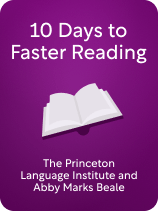

This article is an excerpt from the Shortform book guide to "10 Days to Faster Reading" by The Princeton Language Institute and Abby Marks Beale. Shortform has the world's best summaries and analyses of books you should be reading.
Like this article? Sign up for a free trial here.
Do you tend to read at the same speed that you talk? Do you lose your place or your focus when you read?
The book 10 Days to Faster Reading provides several strategies for quicker, more effective reading. One way to improve your reading speed is by addressing three bad reading habits: mouthing or speaking the words, accidentally rereading what you’ve already read, and getting lost in thought.
Let’s take a look at several behaviors that people commonly engage in that slow down their reading—along with some tips for breaking these habits.
Habit #1: Mouthing or Speaking the Words
The first bad reading habit that slows readers down is subvocalizing, which is mouthing, reading aloud, or silently reading the words in a text at the rate of speech. The rate at which we speak is much slower than the rate at which we can think and read. So, if you’re reading at a speaking rate, you’ll get through a text much more slowly.
(Shortform note: Though reading aloud slows us down, some researchers have found that it has several benefits we miss out on when we read silently. First, studies conducted with different age groups found that people who read a collection of words aloud remembered those words better than people who read the list silently. To a lesser extent, mouthing the words also improved people’s memory of the text. Additionally, some researchers found that reading aloud helped people understand complicated, difficult texts more easily.)
To reduce subvocalization, the authors suggest putting your pointer finger against your lips, as if you’re telling someone to be quiet. This will remind you not to speak. (Shortform note: Consider listening to instrumental music in addition to placing your finger on your lips. Calm music without lyrics helps reduce subvocalization and aids with concentration.)
Habit #2: Unintentionally Rereading
Another bad reading habit the authors discuss is rereading parts of a text by accident. As untrained readers move through a text, their eyes often unconsciously drift back to portions they’ve already read. This adds time by slowing their progress. Readers often do this because they’re unfocused.
To stop yourself from unintentionally rereading, take a blank note card and place it at the top of the page. As you read, move the notecard down so it covers the portion of the text you’ve already read. If your eyes drift, the bottom of the notecard will indicate where to resume reading.
(Shortform note: Some research indicates that preventing yourself from backtracking may hinder comprehension. One study found that when sentences participants had already read in a text were covered up, the participants’ comprehension was markedly worse than when their eyes were able to jump back to previous parts of the text. Therefore, eye movements that jump back to sentences we’ve already read may play a significant role in our ability to understand a text. This research focused on speed-reading apps that block readers from backtracking, but the same principle could apply to anything that covers text, including a notecard.)
Habit #3: Getting Lost in Thought
Finally, people often read slowly because their thoughts drift to subjects that have little to do with the text. According to the authors, this affects reading speed and comprehension, as you continually have to redirect your attention back to the text.
(Shortform note: If your mind wanders while you’re reading, it may be because you don’t like what you’re reading. Some researchers think that we get lost in thought when the task we’re doing isn’t rewarding or engaging enough. When our brains find a task boring, they search for something else more interesting to think about.)
However, consciously directing your thoughts toward topics that are related to the text can help you remember what you read. Our brains remember new information by connecting it to things we already know, so connecting what you read to existing knowledge creates a lasting memory. For example, if you’re reading about the diet of a giraffe, you might connect what you read to a memory you have of feeding giraffes at your local zoo, creating a mental map between your past experience and the new facts.
(Shortform note: Our ability to make memories through association starts at the cellular level—according to Joshua Foer in Moonwalking With Einstein, our brains are made up of a web of interconnected neurons. Physiologically, memories are arrangements of connections between these neurons, so no memories exist in isolation. To retrieve memories, we must search for pieces of information by thinking about other things that are connected to them in this neural web of associations. Any connection you make between your experience and what you read will likely make a new connection between your neurons, forming a memory.)

———End of Preview———
Like what you just read? Read the rest of the world's best book summary and analysis of The Princeton Language Institute and Abby Marks Beale's "10 Days to Faster Reading" at Shortform.
Here's what you'll find in our full 10 Days to Faster Reading summary:
- Speed-reading techniques to help you learn more efficiently
- How to rid yourself of the common unhelpful reading habits
- How to teach your eyes to take in more information at once






